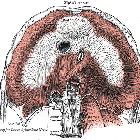Cupola sign (pneumoperitoneum)

Cupola sign
• Pneumoperitoneum - Ganzer Fall bei Radiopaedia

Cupola sign
• Pneumoperitoneum - Ganzer Fall bei Radiopaedia

Cupola sign
• Duodenal perforation due to blunt trauma - Ganzer Fall bei Radiopaedia
The cupola sign is seen on a supine chest/abdominal radiograph in the presence of pneumoperitoneum.
It refers to non-dependent gas that rises within the abdominal cavity of the supine patient to accumulate underneath the central tendon of the diaphragm in the midline. It is seen as lucency overlying the lower thoracic vertebral bodies. The superior border is well defined, but the inferior margin is not .
History and etymology
It was first described in 1986 by Robert Mindelzun and James McCort (1913-2006) who were both Professors of Radiology at Stanford .
"Cupola" is an architectural term, referring to a small dome (in particular, a small dome crowning a roof or a turret) . The word derives from a Latin word for a "little cup".
Siehe auch:
und weiter:

 Assoziationen und Differentialdiagnosen zu cupola sign:
Assoziationen und Differentialdiagnosen zu cupola sign:

